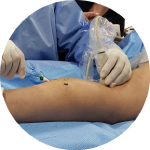
In a recent presentation, Mark H. Meissner, MD, said that a thorough initial assessment of patients presenting with possible venous disease will help physicians provide them with the best treatment. This is important especially because about 250 million Americans have venous disease.
Readers who subscribe to Vein Global can listen to Dr. Meissner’s lecture.
The starting point, he said, is to understand the differences between chronic venous disease (CVD) and chronic venous insufficiency. The former is any manifestation of venous disease, whereas the latter is skin changes associated with venous hypertension.
There are 4 steps in assessing these patients: obtaining the medical history, conducting the physical examination, using venous duplex ultrasonography for assessment, and choosing the proper venous classification instrument.
Step 1: The History
- Check for these primary symptoms:
- Pain, aching, and heaviness
- A sensation of swelling (>5% volume increase) or visible swelling (>8% volume increase)
- Itching
- Phlebalgia (pain at the site of a visible vein)
When patients can feel swelling that might not yet be clinically detectable, this is an important marker for CVD.
- Check for these atypical symptoms:
- Bursting pain with exercise (venous claudication)
- Pelvic disorders: pelvic pain, urinary symptoms, dyspareunia
It’s important to ask about pelvic symptoms when women present with venous disease. Often, they will not know that such symptoms can be related to venous disease and so might not report them.
- Check for exacerbating factors:
- Pain that is worse in the heat and at the end of the day
- Pain that is relieved with elevation and compression
- In getting a medical history, look for these items:
- Pregnancies
- Previous acute deep vein thrombosis (DVT)
- Compression use
- Previous vein procedures
Research has shown by comparing patients who had the following CVD symptoms and reflux with those who had neither that those in the first group were most likely to have CVD and reflux:
- Sensation of heavy legs (likelihood ratio: 2.04)
- Sensation of swollen legs (likelihood ratio: 2.17)
- Itching (likelihood ratio: 9.67)
- “Impatient” legs (likelihood ratio: 4.45)
- Phlebalgia (likelihood ratio: 22.91)
- Pain not being present when the patient awoke (likelihood ratio: 1.45)
- Pain being worse in the heat (likelihood ratio: 2.75)
For more details on that research, see “Ascribing Leg Symptoms to Chronic Venous Disorders: The Construction of a Diagnostic Score,” by Patrick H. Carpentier, Caroline Poulain, Régine Fabry, et al, in the Journal of Vascular Surgery (2007; volume 46, issue 5).
- Check for systemic causes:
- Cardiac failure
- Pulmonary hypertension and/or sleep apnea
- Medications
- Renal failure
- Protein-losing nephropathy
- Hypoalbuminemia
- Check for local causes:
- DVT
- CVD
- Lymphedema
- Lipedema
- Trauma and postoperative issues
- Cellulitis
- Reflex sympathetic dystrophy
- Cyclical conditions
- Idiopathic conditions
Do not ignore medical possibilities related to swelling.
Step 2: The Physical Examination
- Check the location and distribution of veins that may be problematic.
- Typical truncal locations of venous diseases:
- Great saphenous vein
- Anterior accessory saphenous vein
- Small saphenous vein
- Atypical locations of venous diseases:
- Vulva, perineum, and gluteal cleft
- Lateral marginal vein
- Groin and abdominal-wall collaterals
- Look for skin changes.
- Consider the distribution of edema:
- If it is in the foot and toes, suspect lymphedema.
- If it is ankle- and foot-sparing, suspect lipedema.
- If it is in the thigh, suspect proximal obstruction.
Every patient should at least have their pulses checked. Possibly, they should also undergo testing for their ankle-brachial index.
- Look for different types of abnormal veins:
- Telangiectasias are larger than 1 mm in diameter, are red to purple, and blanch and refill quickly.
- Venulectasias are larger blue venules and may be palpable, but they are not varicose veins.
- Reticular veins are 1 to 3 mm in diameter, are blue, and have the primary responsibility of heat dissipation in the body. Most are normal veins in fair-skinned individuals, but they may be associated with telangiectasias.
- Varicose veins are larger than 3 mm in diameter, are palpable, and usually do not have any discoloration.
To determine the right treatment, it is important to know the level at which the various types of veins arise.
- Check the skin and subcutaneous tissue for these issues:
- Hyperpigmentation
- Venous eczema
- Corona phlebectatica (a fan-shaped distribution of blue veins over the ankle)
- Atrophie blanche (probably represents microthrombosis in the skin)
- Ulceration
- Look for other venous skin changes that are not included in the CEAP (clinical, etiological, anatomical, and pathophysiological) classes:
- Pigmented purpuric dermatosis
- Has “cayenne pepper” pigmentation
- 78% with associated venous disease
- 2% platelet abnormalities (von Willebrand factor; fish oil)
- Acroangiodermatitis (pseudo-Kaposi sarcoma)
- Macular pigmentation
- Possible association with arteriovenous malformation (Stewart-Bluefarb syndrome)
- Livedoid vasculopathy
- Reticulate pigmentation with recurrent ulcers
- Atrophie blanche
- Microvascular thrombosis
- Coagulation defects (antiphospholipid syndrome, factor V Leiden)
Not all skin changes are venous, so it is advisable to consult a dermatologist.
Step 3: Venous Duplex Ultrasonography
Reflux should always be assessed when patients are in the upright position. The problem with assessing patients when they are in the supine position is that it generates both false negatives and false positives.
Step 4: Venous Classification Instruments
- The CEAP
- Is a discriminative instrument, not a severity score
- Puts patients in bins with similar
- Clinical features
- Natural history
- Response to treatment
- Does not account for abdominal or pelvic
- The Venous Clinical Severity Score
- Is an evaluative instrument
- Measures change over time or with treatment
A subscription to Veinglobal.com provides access to more than 200 on-demand instructional, inspirational, and innovative presentations on surgical procedures, practice management, research data, and more. Vein Global is a tool for your entire practice to stay current on venous education.
Recent Posts

Review of Radiofrequency Ablation Devices

Overtreatment in CVD Leads to Superficial Ablation Abuse

Ultrasound-guided Foam Sclerotherapy

Recurrent Stent Occlusion: Endovenectomy, Bypass, or Compression Only

Optimizing Deep Vein Images: The Profunda Femoris Vein

A Closer Look at Swollen Legs: Edema Differentiation

Vein Global and IVC are Evolving to Launch the Next Decade of Endovascular Innovation and Education

Phlebectomy: Technical Steps with Jose I. Almeida, MD, FACS, RPVI, RVT

The Spectrum of Vacuum-Assisted Venous Thrombectomy

Sclerotherapy: Technical Steps with Julian J. Javier, MD, FSCAI, FCCP

